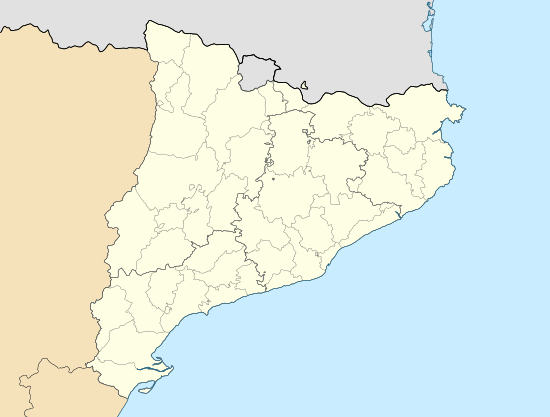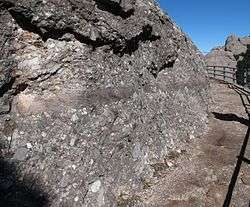Montserrat (mountain)
| Montserrat | |
|---|---|
|
Montserrat seen from Manresa | |
| Highest point | |
| Elevation | 1,236 m (4,055 ft) |
| Coordinates | 41°35′30″N 1°50′16″E / 41.59167°N 1.83778°ECoordinates: 41°35′30″N 1°50′16″E / 41.59167°N 1.83778°E |
| Geography | |
 Montserrat | |
| Parent range | Catalan Pre-Coastal Range |
| Geology | |
| Mountain type | Conglomerate |
| Climbing | |
| Easiest route | Via road BP-1121 from Monistrol de Montserrat |
Montserrat (Catalan pronunciation: [munsəˈrat]) is a multi-peaked mountain range near Barcelona, in Catalonia, Spain. It is part of the Catalan Pre-Coastal Range. The main peaks are Sant Jeroni (1,236 m), Montgrós (1,120 m) and Miranda de les Agulles (903 m).[1]
It is well known as the site of the Benedictine abbey, Santa Maria de Montserrat, which hosts the Virgin of Montserrat sanctuary and which is identified by some [2] with the location of the Holy Grail in Arthurian myth.
"Montserrat" literally means "saw (serrated, like the common handsaw) mountain" in Catalan. It describes its peculiar aspect with multitude of rock formations which are visible from a great distance. The mountain is composed of strikingly pink conglomerate, a form of sedimentary rock. Montserrat was designated as a National Park in 1987.
In 1493, Christopher Columbus named the Caribbean island of Montserrat Santa Maria de Montserrate, after the Virgin of Montserrat.[3]
Access
The Benedictine Abbey can be reached by road, by the Aeri de Montserrat cable car, or by the Montserrat Rack Railway. The lower stations of both the rack railway and the cable car can be reached by Ferrocarrils de la Generalitat de Catalunya train from Barcelona's Plaça d'Espanya station. From the abbey, the Funicular de Sant Joan funicular railway goes up to the top of the mountain, where there are various abandoned hovels in the cliff faces that were previously the abodes of reclusive monks, while the Funicular de la Santa Cova descends to a shrine.
Hiking and climbing
The highest summit of Montserrat is called Sant Jeroni (Saint Jerome) and stands at 1,236 meters (4,055 feet) above sea-level. It is accessible by hiking trails which connect from the top entrance to the Sant Joan funicular, the monastery, or the base of the mountain.
The Cavall Bernat 1,111 meters (3,645 feet) is an important rock feature popular with climbers.
Geology


Montserrat is formed of conglomerate that was originally deposited in a fan delta at the margin of the Ebro Basin, part of the foreland basin to the Pyrenees, during the middle Eocene. The conglomerate was derived from the uplifting Catalan Coastal Ranges to the southeast of the basin and the clast type is dominated by Triassic sedimentary rocks. The fan had an original size of between 100–150 square kilometres.[4] The resistance of the Montserrat conglomerate to erosion compared to the rest of the fill of the Ebro Basin explains its current mountainous nature.[5]
The dominant clast lithology in the conglomerate is limestone and the sequence is cemented by calcite. The presence of so much carbonate in the rock has led to the formation of typical karst landforms, such as cave systems.[5]
References
- ↑ Mapa Topogràfic de Catalunya - Institut Cartogràfic de Catalunya
- ↑ Wolfram von Eschenbach Archived 2007-07-15 at the Wayback Machine., "Parzival", The legend stems from the Medieval German tale that refers to a mountain called Monsalvat as the location of the grail.
- ↑ The Complete Guide to National Symbols and Emblems: Volume 2, page 724
- ↑ López-Blanco M.; Marzo M.; Burbank D.W.; Vergés J.; Roca E.; Anadón P.; Piña J. (2000). "Tectonic and climatic controls on the development of foreland fan deltas: Montserrat and Sant Llorenç del Munt systems (Middle Eocene, Ebro Basin, NE Spain)" (PDF). Sedimentary Geology. 138 (1–4): 17–39. doi:10.1016/S0037-0738(00)00142-1.
- 1 2 Guerrero J.; Gutiérrez F.; Gutiérrez M. (2014). Gutiérrez F.; Gutiérrez M., eds. Conglomerate Monoliths and Karst in the Ebro Cenozoic Basin, NE Spain. Landscapes and Landforms of Spain. Springer. ISBN 978-94-017-8627-0.
External links
| Wikivoyage has a travel guide for Montserrat (Spain). |
| Wikimedia Commons has media related to Montserrat. |
- LARSA Montserrat Montserrat General Information
- Gallery of oblique aerial photos of Montserrat, by Doc Searls
- Getting to Montserrat from Barcelona city
